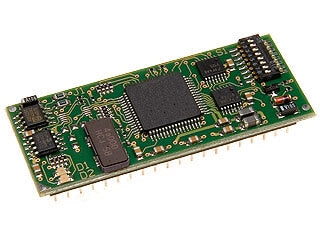
CANopen Chip-F40
EOL NOTIFICATION: Product is at its end of life and will no longer be available once stock is depleted.
The CANopen-Chip F40, equipped with Fujitsu’s MB90F40xxx CAN controller, offers on-chip Flash, SRAM, and CAN. It serves as a plug-and-play node in a CANopen network due to its resident firmware. A programmable version, DIPmodul-F40, is available without the CANopen firmware. The CANopen version supports NMT-slave as per CiA DS 301 V4.0 and device profiles per CiA DSP 401. Bit rate is adjustable via DIP switch or LSS, with I/Os dependent on configuration.
The DIPmodul/CANopen Chip Carrier Board provides a flexible platform for easy start-up and programming. It facilitates operation of the module in a CAN bus system and connection to expansion boards for rapid prototyping and software evaluation.
I/O Node:
- Single Board CANopen node in 40-pin DIP dimensions
- 11-bit 2.0B message identifier
- Supports NMT-slave; device profiles; Lifeguarding, Nodeguarding, Heartbeat Consumer, Heartbeat Producer
- 4 x TxPDO asynchronous/synchronous RTR event timer; 2 x RxPDO asynchronous/synchronous variable PDO mapping; 1 x SDO server, SYNC consumer, Emergency message
- Bit rate configurable via DIP switch or LSS
- Node ID address via DIP switch or LSS
- EEPROM for network parameters/configuration
- Red/green status LEDs
- To 24 x digital inputs, to 24 x outputs (TTL level)
- To 8 x analog inputs (configuration dependent, 0V to 5V, 10-bit resolution)
- 5V power supply
Carrier Board:
- EURO-card dimensions (160 x 100 mm)
- DB-9 socket for serial RS-232 interface connectivity
- DB-9 plug for CAN interface connectivity
- Insertable jumpers enabling configuration of I/O signals
- CAN bus interface circuitry
- RS-232 interface
- 4x push buttons for digital input simulation
- 4x user LEDs for digital output simulation
- 2x potentiometers for analog input simulation
- 1x general purpose input/output connector for easy connection of external peripheral devices
- 1x additional RUN-/STOP switch (for IEC1131-PLC-Chip)
- 2x additional LEDs for RUN/STOP and ERROR indication (for IEC1131-PLC-Chip)
- Wire wrap field supporting development of user-designed peripheral hardware
- Reset switch (configurable signal level)
- Boot switch (configurable signal level)
- Low voltage terminal block connects to a voltage regulator accepting an unregulated input voltage in a range from 8V to 13V
- Voltage regulator 5VDC / 1 A (optionally 3.3VDC or adjustable)
EOL NOTIFICATION No longer available for purchase.
| Controller | Fujitsu MB90F352 16-bit microcontroller |
| Operating voltage | 5V ±10% |
| Current consumption | typically 65mA, max. 140mA depends on circuitry of I/Os and CAN |
| Storage | Non-volatile memory for storage of configuration data |
| Configuration | DIP-switches for easy configuration of node ID, baud rate and IO configuration |
| Available I/O configuration | Seven different IO configurations on 28 IO pins, selectable via DIP-switch and Object Dictionary |
| Digital outputs | GND < L-level < 0.4V 4.5V < H-level < VCC |
| Digital inputs | GND - 0.3V < L-level < 0.8V 0.8 VCC < H-level < VCC + 0.3V |
| Analog inputs | Input voltage: VAGND … VREF Logical resolution: 15-bit signed (OD value) Physical resolution: 10-bit (see manual) Input capacity: 10.7pF Reference voltage: +2.7V ... VCC |
| PWM outputs | See digital outputs for details PWM frequency: max. 21kHz (CAN>10kBit) PWM frequency: max. 11,5kHz (CAN=10kBit) |
| CAN transceiver | on-board PCA82C251, supporting up to 100 nodes on one CAN bus |
| CAN bus bitrate | 10kBit/s to 1Mbit/s |
| Operating temperature | -40°C to +85°C |
| Storage temperature | -40°C to +90°C |
| Dimensions (LxWxH) | 58,7mm x 24,0 mm x 11,8 ±0,3 mm |
| Weight | ca. 10,5g |
| Socket connector | 40-pin Dual-Inline-IC-socket, grid dimension 2,54 x 15,24 |
| Pin-header | grid dimension 2,54 mm, Ø0,47mm, pin length 3,2 mm |
| Datasheet |
| CANopen ChipF40 - Datasheet |
| System Manual |
| CANopen ChipF40 - System Manual |
